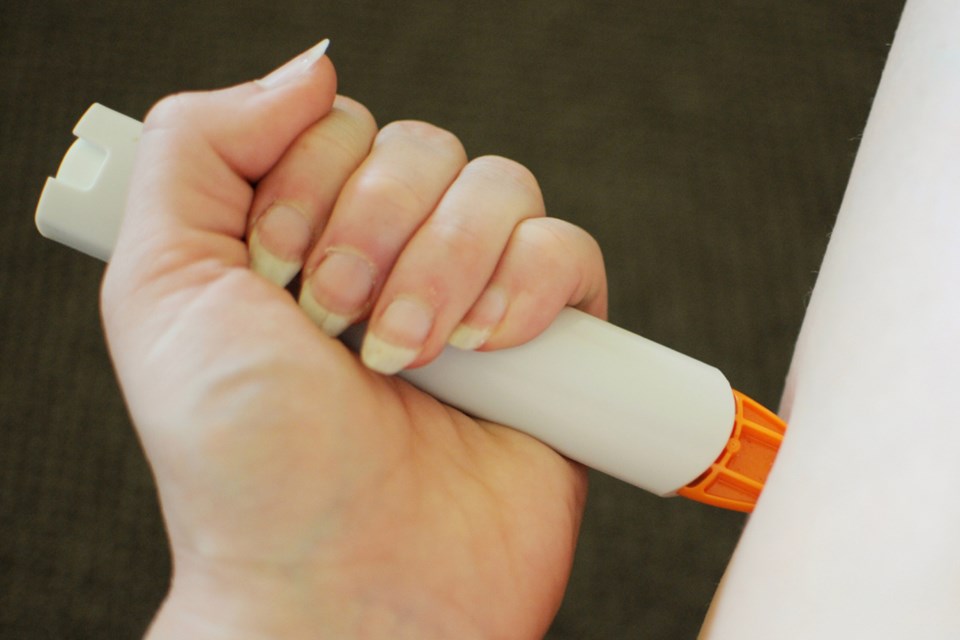Health
Medical Experts Urge Immediate Use of EpiPens for Anaphylaxis

A recent article published in the Canadian Medical Association Journal emphasizes the critical role of epinephrine in managing anaphylaxis, a severe allergic reaction that can be life-threatening. The piece highlights that epinephrine, delivered via an auto-injector such as the epi-pen, is the only treatment that can prevent fatalities during such emergencies.
The article asserts that “Intramuscular epinephrine rapidly reverses airway edema and shock,” and warns against relying on less effective alternatives. Current medical evidence indicates that antihistamines and corticosteroids do not prevent the progression of anaphylaxis or subsequent biphasic reactions. This underlines the importance of administering epinephrine without delay, as waiting for other medications could prove dangerous.
Anaphylaxis is often triggered by common allergens, including peanuts, tree nuts, milk, eggs, fish, shellfish, and sesame seeds. Alarmingly, Health Canada estimates that approximately 600,000 Canadians are at risk for life-threatening allergic reactions, a figure that is on the rise, particularly among children.
As some patients are hesitant to use needle-based treatments like the epi-pen, an intranasal epinephrine spray is being explored as an alternative. Although this option is currently unavailable in Canada, the article notes that it has been approved in the United States. “Intranasally delivered epinephrine could benefit those with needle phobia or other limitations,” the article states, highlighting the potential for broader access to life-saving treatments.
While the nasal spray remains under review in Canada, officials are considering it for patients aged four years and older who weigh at least 15 kilograms. As of November 2025, the status of this option is still pending approval.
The article also discusses varying recommendations for emergency medical services (EMS) following the administration of epinephrine. A 2023 update on anaphylaxis practice parameters suggests that home observation may be appropriate if symptoms completely resolve within 10 to 15 minutes after a single dose. However, the Canadian Paediatric Society advises that all children who receive epinephrine should be assessed in an emergency department.
Auto-injectors are recommended for all individuals experiencing anaphylaxis for the first time, as well as those with a history of prior reactions. The article adds that individuals exhibiting less severe allergic reactions, those with certain risk factors such as mast cell disorders or uncontrolled asthma, and those living more than 30 minutes away from EMS should also be provided with self-injectable epinephrine.
For more detailed information, the full text of the article can be accessed online.
-

 Education2 months ago
Education2 months agoBrandon University’s Failed $5 Million Project Sparks Oversight Review
-

 Lifestyle3 months ago
Lifestyle3 months agoWinnipeg Celebrates Culinary Creativity During Le Burger Week 2025
-

 Science3 months ago
Science3 months agoMicrosoft Confirms U.S. Law Overrules Canadian Data Sovereignty
-

 Health3 months ago
Health3 months agoMontreal’s Groupe Marcelle Leads Canadian Cosmetic Industry Growth
-

 Science3 months ago
Science3 months agoTech Innovator Amandipp Singh Transforms Hiring for Disabled
-

 Technology3 months ago
Technology3 months agoDragon Ball: Sparking! Zero Launching on Switch and Switch 2 This November
-

 Education3 months ago
Education3 months agoRed River College Launches New Programs to Address Industry Needs
-

 Technology3 months ago
Technology3 months agoGoogle Pixel 10 Pro Fold Specs Unveiled Ahead of Launch
-

 Technology1 month ago
Technology1 month agoDiscord Faces Serious Security Breach Affecting Millions
-

 Business2 months ago
Business2 months agoRocket Lab Reports Strong Q2 2025 Revenue Growth and Future Plans
-

 Science3 months ago
Science3 months agoChina’s Wukong Spacesuit Sets New Standard for AI in Space
-

 Education3 months ago
Education3 months agoAlberta Teachers’ Strike: Potential Impacts on Students and Families
-

 Technology3 months ago
Technology3 months agoWorld of Warcraft Players Buzz Over 19-Quest Bee Challenge
-

 Business3 months ago
Business3 months agoNew Estimates Reveal ChatGPT-5 Energy Use Could Soar
-

 Business3 months ago
Business3 months agoDawson City Residents Rally Around Buy Canadian Movement
-

 Technology1 month ago
Technology1 month agoHuawei MatePad 12X Redefines Tablet Experience for Professionals
-

 Education3 months ago
Education3 months agoNew SĆIȺNEW̱ SṮEȽIṮḴEȽ Elementary Opens in Langford for 2025/2026 Year
-

 Technology3 months ago
Technology3 months agoFuture Entertainment Launches DDoD with Gameplay Trailer Showcase
-

 Business3 months ago
Business3 months agoBNA Brewing to Open New Bowling Alley in Downtown Penticton
-

 Technology3 months ago
Technology3 months agoInnovative 140W GaN Travel Adapter Combines Power and Convenience
-

 Technology3 months ago
Technology3 months agoGlobal Launch of Ragnarok M: Classic Set for September 3, 2025
-

 Science3 months ago
Science3 months agoXi Labs Innovates with New AI Operating System Set for 2025 Launch
-

 Technology3 months ago
Technology3 months agoNew IDR01 Smart Ring Offers Advanced Sports Tracking for $169
-

 Technology3 months ago
Technology3 months agoDiscover the Relaxing Charm of Tiny Bookshop: A Cozy Gaming Escape










